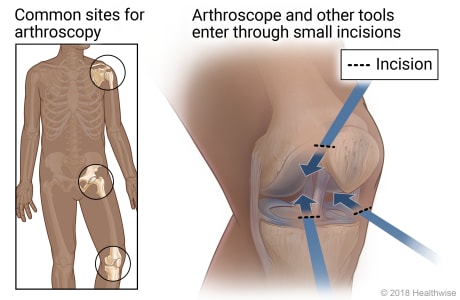Arthroscopy for Rheumatoid Arthritis
Surgery Overview
Arthroscopy is a type of joint surgery in which a thin tube with a light source (called an arthroscope) is inserted into the joint through a small incision (cut) in the skin. This allows the doctor to see the inside of the joint. Special tools are inserted through other small cuts to work on the joint. Surgery will not cure rheumatoid arthritis or stop the disease's progress. But it may improve function and provide some pain relief.
How It Is Done

Arthroscopic surgery (arthroscopy) is a surgical procedure that allows your doctor to look at the inside of a joint in your body through a thin viewing instrument called an arthroscope. Common sites for the procedure include the shoulder, hip, and knee.
During arthroscopy, the arthroscope is inserted into your joint through a small cut (incision) in the skin. The arthroscope has a light source and a video camera attached to it. Images from the camera can be seen on a video monitor. These magnified images provide a clear picture of your joint. A sample of joint tissue can be collected during arthroscopy for biopsy. If surgery is done, additional instruments will be inserted into your joint through other small incisions.
What To Expect
Arthroscopy usually does not require an overnight stay in the hospital. After the procedure, the joint should be used as little as possible for several days. You may need crutches if your foot or knee joint was examined. It depends on the extent of the procedure and what your doctor prefers.
Why It Is Done
This procedure is used for treatment in large joints. Procedures done with arthroscopy include:
- Cleansing and removing debris from the joint (irrigation).
- Removing any free-floating pieces of bone or cartilage from the joint.
- Smoothing out rough or irregular joint surfaces.
- Limited removal of inflamed tissues (synovectomy) in larger joints.
This procedure may not be the right choice if joint destruction is severe.
How Well It Works
Arthroscopy temporarily relieves pain and sometimes eases joint movement. But it does little to slow the progression of the disease.footnote 1
Risks
Risks of arthroscopy include the risks of surgery and using anesthetic. There's also a slight risk of infection and bleeding within the joint.
References
Citations
- Chalmers PN, et al. (2011). Rheumatoid synovectomy: Does the surgical approach matter? Clinical Orthopaedics and Related Research, 469(7): 2062–2071. DOI: 10.1007/s11999-010-1744-3. Accessed September 25, 2021.
Credits
Current as of: July 31, 2024
Current as of: July 31, 2024
Chalmers PN, et al. (2011). Rheumatoid synovectomy: Does the surgical approach matter? Clinical Orthopaedics and Related Research, 469(7): 2062–2071. DOI: 10.1007/s11999-010-1744-3. Accessed September 25, 2021.